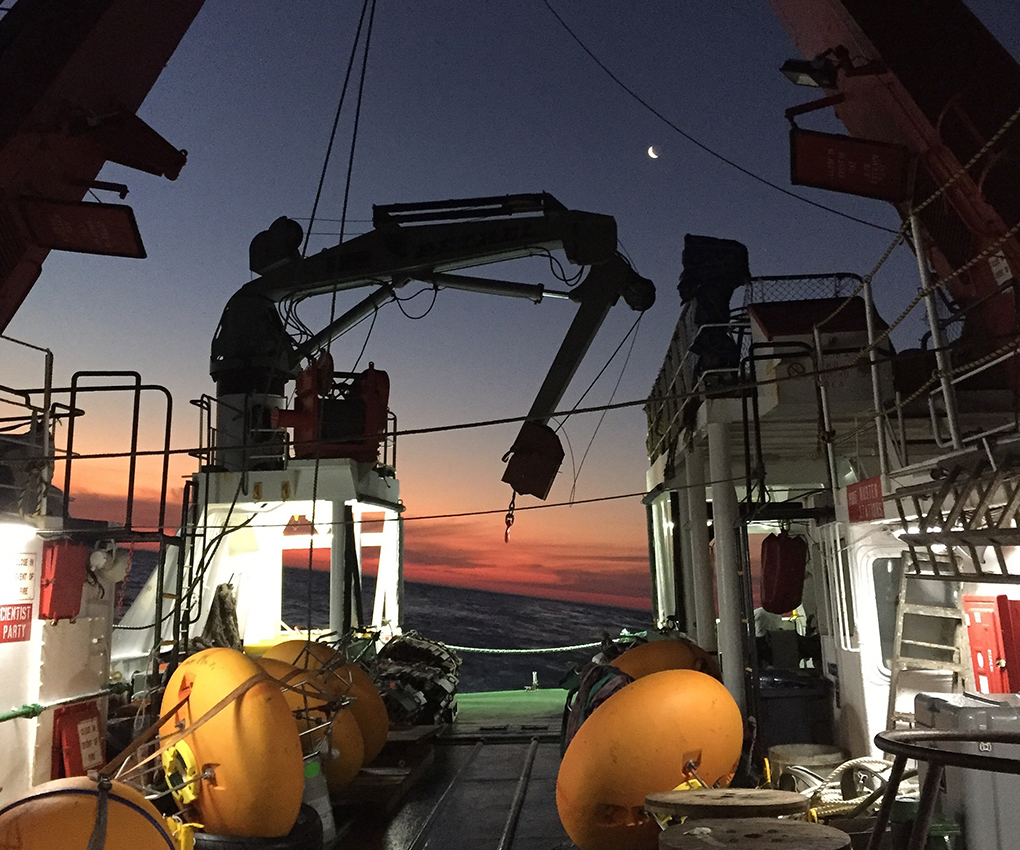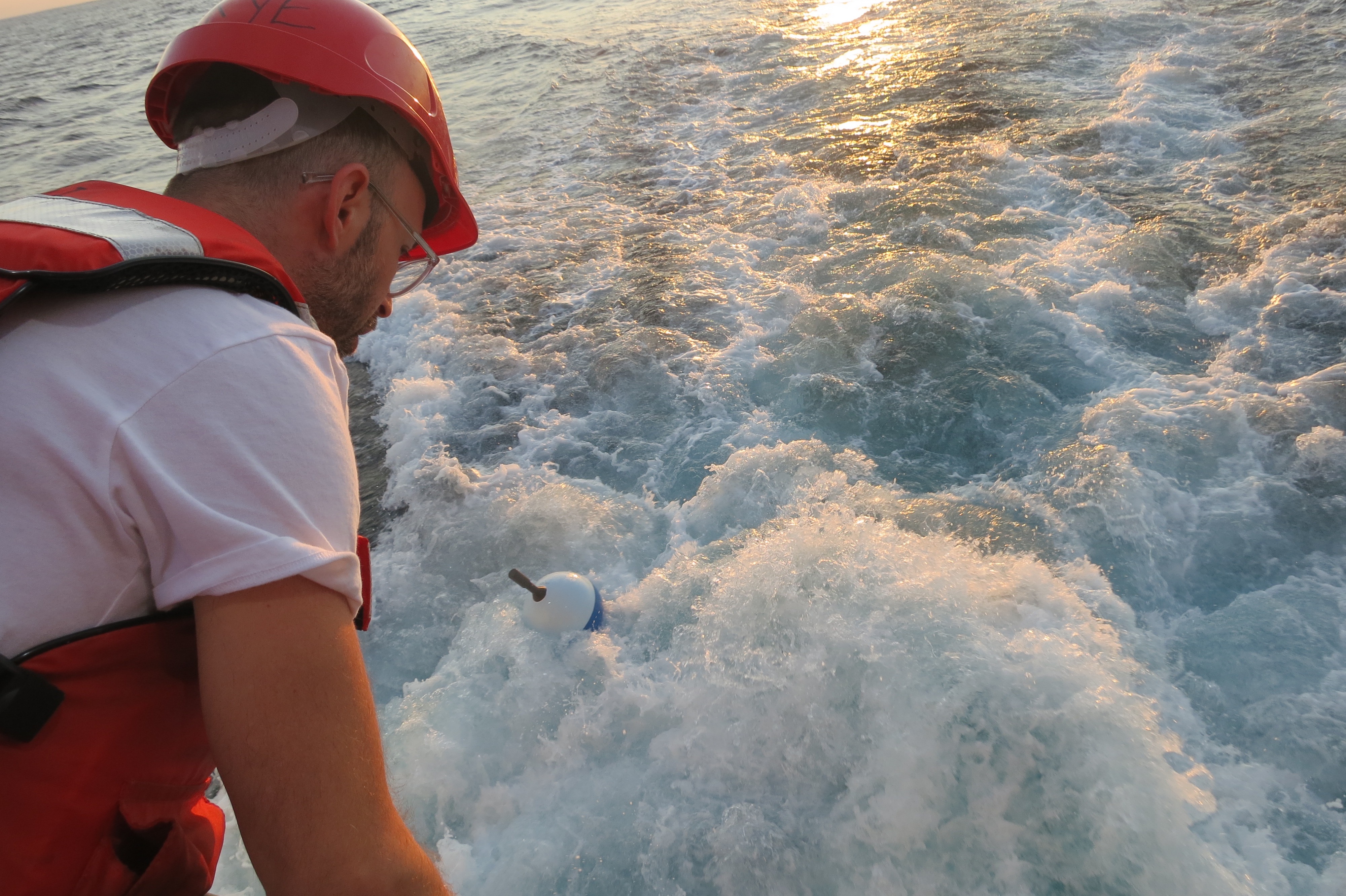
Photo : Acadia National Park, Maine, LAPCOD 2015 meeting
Past Projects
The Agulhas System Climate Array (ASCA)

I am a co-PI of the Agulhas System Climate Array (ASCA) project, led by Prof Lisa Beal and funded by the U.S.A. National Science Foundation (NSF) for its US component. More broadly, ASCA is an international research project with partners from South Africa, the USA, and the Netherlands, with funding support from the South African Departments of Science and Technology (DST) and Environmental Affairs (DEA), the US National Science Foundation (NSF) and the Royal Dutch Institute for Sea Research (NIOZ). It is designed to provide long term observations of Agulhas Current volume, heat and salt transport and its variability from mesoscale (eddies), through seasonal to interannual timescales. This is achieved by means of two shelf and seven full-depth tall moorings, interspersed with five Current- and Pressure-recording Inverted Echo Sounders (CPIES), measuring pressure, current velocities, temperatures and salinities. The ASCA shelf and tall moorings extend 200 km offshore along the descending TOPEX/Jason satellite ground track #96, through the core of the Agulhas Current, with CPIES measurements extending the array to 300 km offshore. The project has generated the following publications:
-
Kathryn L. Gunn, K. McMonigal, Lisa M. Beal, Shane Elipot, and Elaine McDonagh (2022), Indian Ocean remains net evapourative, submitted to the Journal of Physical Oceanography.
-
McMonigal, K., Kathy Gunn, Lisa Beal, Shane Elipot, and Josh K. Willis (2021), Reduction in meridional heat export contributes to recent Indian Ocean warming, Journal of Physical Oceanography, 50(12), doi:10.1175/JPO-D-21-0085.1
-
Kathryn L. Gunn, Lisa M. Beal, Shane Elipot, K. McMonigal, and Adam Houk (2020), Mixing of Subtropical, Central and Intermediate Waters Driven by Shifting and Pulsing of the Agulhas Current, Journal of Physical Oceanography, 50(12), doi:10.1175/JPO-D-20-0093.1.
-
K. McMonigal, Lisa M. Beal, Shane Elipot, Kathryn L. Gunn, Juliet Hermes, Tamaryn Morris, and Adam Houk (2020), The Impact of Meanders, Deepening and Broadening, and Seasonality on Agulhas Current Temperature Variability, Journal of Physical Oceanography, 50(12), doi:10.1175/JPO-D-20-0018.1
-
Vermeulen, E., B. Backeberg, J. Hermes, and S. Elipot (2019), Investigating the relationship between volume transport and sea surface height in a numerical ocean model, Ocean Sci., 15, 513-526, doi:10.5194/os-15-513-2019
-
Elipot, S., and L. M. Beal (2018), Observed Agulhas Current sensitivity to interannual and long-term trend atmospheric forcings, J. Clim., 31, 3077-3098, doi: 10.1175/JCLI-D-17-0597.1.
This paper has been selected as a research highlight for Nature Climate Change: G. Simpkins (2018), Nature Climate Change 8, 188, doi:10.1038/s41558-018-0111-3.
- This paper studies the atmosphere-driven interannual variability of the Agulhas jet transport based on the altimeter proxy derived in Beal and Elipot (2016). We find that 29% of the interannual variance of the Agulhas Current transport can be linearly related to six modes of Southern Hemisphere atmospheric variability, including ENSO and a SAM-related mode. The Agulhas transport proxy time series can be downloaded via the ACT website here.
Global Observational Constraints on Oceanic Response to Wind Forcing

I lead this NSF-funded collaborative research project with Dr. J.M. Lilly now at Planetary Science Institute and Dr. R. Harcourt from the Applied Physics Laboratory of the University of Washington. The goal of this project is to better understand the dynamics of the ocean surface boundary layer through the first global study of the wind stress to ocean current transfer function. This is to be accomplished by analyzing in detail the response to wind forcing in the global array of surface drifters, which sample the ocean currents in the vicinity of their 15 m drogue depth. The global analysis is to be informed and tested by (i) a prototype study from the SPURS region, near a well-instrumented air-sea flux mooring, and (ii) analysis of synthetic data generated with a recently improved turbulence closure model that explicitly includes Langmuir turbulence. The hypotheses that wind, wave, and stratification state substantially modify near-surface mixing will be tested by examining dependencies of the transfer function on various environmental parameters, such as Langmuir number. Observed patterns will then be interpreted and scrutinized by deriving new theoretical approximations to the expected transfer functions characterizing different mixing processes. This project is officially closed but its related science questions are still very much an area of research for me. This project as generated two publications so far:
- Jonathan M. Lilly and Elipot, S. (2021), A Unifying Perspective on Transfer Function Solutions to the Unsteady Ekman Problem, Fluids, 6(2), 85, dpoi:10.3390/fluids6020085
This paper is a revisit of some theoretical aspects of my PhD work, expanding and unifying previous studies including some of the material presented in Elipot and Gille (2009a).
- Elipot S., R. Lumpkin, R. C. Perez, J. M. Lilly, J. J. Early, and A. M. Sykulski (2016), A global surface drifter dataset at hourly resolution, J. Geophys. Res.-Oceans, 121, doi:10.1002/2016JC011716.
An new global hourly surface drifter dataset
I have produced with colleagues at AOML a new global surface drifter dataset at hourly resolution. This dataset is freely available through the Global Drifter Program Data Assembly Center hosted at NOAA/AOML in Miami, FL. The dataset is described in Elipot S., R. Lumpkin, R. C. Perez, J. M. Lilly, J. J. Early and A. M. Sykulski (2016), A global surface drifter dataset at hourly resolution, doi:10.1002/2016JC011716. The dataset is regularly updated as new drifter data become available and improvements in the methodology are being made. This project was partly supported by The Cooperative Institute for Marine and Atmospheric Studies (CIMAS).
The Agulhas Current Time-Series Experiment (ACT)
The ACT project was a series of three expeditions to South Africa led by Prof. Lisa Beal. I joined the project after the field work, and focused on the analyses of the moored observation data generated by the project. I have contributed so far to three publications:
- Leber, G. M., L. M. Beal and S. Elipot (2016), Classification of Upwelling Events inshore of the Agulhas Current at 34ºS, in revision for J. Phys. Oceanogr., Sept. 2016
- Beal, L. M., S. Elipot, A. Houk, and G. Leber (2015), Capturing the Transport Variability of a Western Boundary Jet: Results from the Agulhas Current Time-series experiment (ACT), J. Phys. Oceanogr., 45, 1302-1324, doi:10.1175/JPO-D-14-0119.1
- Elipot, S. and L.M. Beal (2015), Characteristics, Energetics, and Origins of Agulhas Current Meanders and their Limited Influence on Ring Shedding, J. Phys. Oceanogr., doi:10.1175/JPO-D-14-0254.1
Monitoring and studying the lower limb of the North Atlantic Meridional Overturning Circulation from in-situ data
I worked at the UK National Oceanography Centre in Liverpool, UK, on mooring observations at several latitudes of the return and deep flow of the North Atlantic Meridional Overturning Circulation (AMOC). The general topic of my research was to understand the variability of the MOC on intra-annual to inter annual time scales. The name of this program funded by the UK NERC is RAPID WAVE from the Rapid Climate Change programme. I have contributed to four peer-reviewed publications for this project:
- Elipot, S. et al. (2016), Observed basin-scale response of the North Atlantic Meridional Overturning Circulation to wind stress forcing, submitted to J. Clim., Sept. 2016
- Elipot, S., E. Frajka-Williams, C. Hughes and J. Willis (2014), The Observed North Atlantic Meridional Overturning Circulation, its Meridional Coherence and Ocean Bottom Pressure, J. Phys. Oceanogr., 44, 517-537, doi:10.1175/JPO-D-13-026.1
- Elipot, S., C. Hughes, S. Olhede and J. Toole (2013), Coherence of western boundary pressure at the RAPID WAVE array: boundary wave adjustements or deep western boundary current advection?, J. Phys. Oceanogr., 43, 744-765, doi:10.1175/JPO-D-12-067.1.
- Hughes, C., S. Elipot, M.A. Morales Maqueda, and J. Loder (2013) Test of a Method for Monitoring the Geostrophic Meridional Overturning Circulation Using Only Boundary Measurements, J. Atmosph. Ocean. Techn., 30,789–809, doi:10.1175/JTECH-D-12-00149.1.
What is the polarization of ocean currents?
This question was the central theme of my postdoctoral research project which was first funded by a postdoctoral fellowship from the National Research Council of the US National Academies. I conducted this research at AOML under the advising of Dr. Rick Lumpkin. The second year of this project was funded by the Cooperative Institute for Marine and Atmospheric Studies of the University of Miami, Miami, Florida, USA. This project led to three publications:
- Elipot, S. and R. Lumpkin (2008), Spectral description of oceanic near-surface variability, Geophys. Res. Lett., 35, L05606, doi:10.1029/2007GL032589.
- Elipot, S., R. Lumpkin and G. A. Prieto (2010), Modification of inertial oscillations by the mesoscale eddy field, J. Geophys. Res.-Oceans, 115, C09010, doi:10.1029/2009JC005679.
- Lumpkin, R. and S. Elipot, (2010), Surface Drifter Pair Spreading in the North Atlantic, J. Geophys. Res.-Oceans, 115, C12017, doi:10.1029/2010JC006338.
The Southern Ocean response to wind forcing
This general theme was the underlying motivation of the PhD project at Scripps Institution of Oceanography at the University of California, San Diego. I was advised by Prof. Sarah Gille. This project led to two peer-reviewed publications in addition to my PhD thesis:
- Elipot, S. and S. T. Gille (2009), Estimates of wind energy input to the Ekman layer in the Southern Ocean from surface drifter data, J. Geophys. Res., 114, C06003, doi:10.1029/2008JC-005170.
- Elipot, S. and S. T. Gille (2009), Ekman layers in the *Southern Ocean: spectral models and observations, vertical viscosity and boundary layer depth*, Ocean Sci., 5, 115-139, doi:10.5194/os-5-115-2009.
- Elipot, S. (2006), Spectral characterization of Ekman velocities in the Southern Ocean based on surface drifter trajectories, Ph.D. dissertation, University of California, San Diego.

